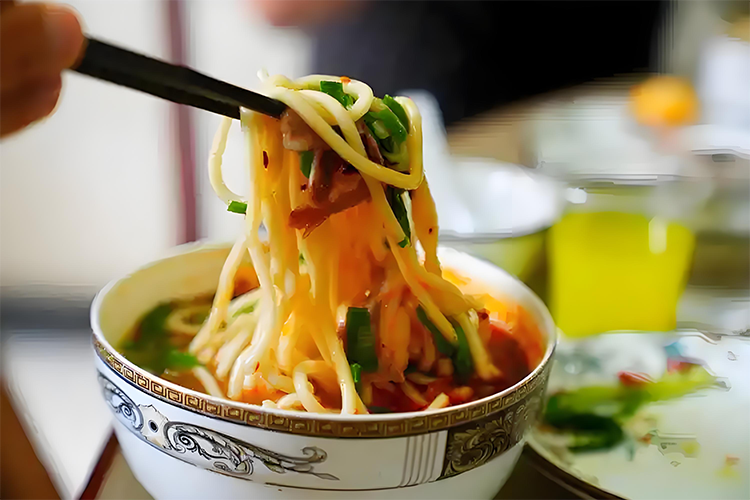Warm Hearty Jiaxian Tofu Soup
1. Origin and History A Soup That Carries Centuries of Central China Flavor
Jiaxian tofu soup is intertwined with the agrarian food traditions of the Central Plains. While its exact origin is hard to pinpoint, it likely developed during the Ming and Qing eras and was refined in Jia County. Henan’s cold, dry winters called for nourishing, high-calorie dishes. Local people used abundant soybeans to make tofu, paired it with energy-rich lamb and lamb bones, and added durable sweet-potato noodles to create a balanced, warming soup. What began as a humble family staple gradually spread to street stalls and old restaurants, becoming Jia County’s most recognizable local specialty.
2. Cultural Significance A Beloved Everyday Comfort
In Jia County, tofu soup is more than food—it’s a cultural marker. It wakes the town in the morning as breakfast, fuels workers at lunch, and reunites friends for a warming late-night snack. Whether in a tiny street stall or a long-established eatery, you’ll see people gathering around bowls, enjoying the aroma of lamb broth and the toasty scent of chili oil. For those who moved away, a bowl evokes deep nostalgia. The dish reflects the practical, sincere character of Central Plains people and their focus on seasonal, affordable, and flavorful meals.

3. Key Ingredients Simple Elements, Extraordinary Taste
- Soulful broth: The base is slow-simmered lamb bones (sometimes with added chicken frames) cooked for hours until the soup turns milky and collagen-rich. The careful simmering produces a deep, savory broth rich in flavor and nutrients.
- Main components: The tofu used is cut into thin, delicate strips—silky and tender on the palate. The noodles are usually sweet-potato vermicelli, which stay springy even after long cooking and soak up the broth. Tender lamb or assorted lamb offal adds depth and texture.
- Finishing touch: The signature chili oil is made by toasting and grinding spices, then pouring hot oil over the mixture to release fragrant, rounded heat—spicy but not overwhelming.
4. Preparation Craftsmanship in Every Detail
A true Jiaxian tofu soup takes patience and technique. Start by simmering cleaned lamb bones in cold water—bring to a boil, skim foam, then simmer on low for four to five hours until the bones are soft and the broth is milky. Keep seasonings minimal to preserve the broth’s pure flavor.
Prepare the toppings: slice silky tofu into thin strips, soak sweet-potato noodles in warm water until pliable, and cook lamb meat or offal until tender. To assemble, place tofu, softened noodles, and lamb in a bowl, then ladle roaring-hot broth over them to gently cook the ingredients and preserve their texture. Finish with chopped cilantro, scallions, and a spoonful of the special chili oil—that final pour brings the dish together with its aromatic warmth.

5. Flavors and Texture A Layered Sensory Experience
Tasting Jiaxian tofu soup is a multi-layered experience. The first sip reveals the rich, savory lamb broth that spreads warmth through your body. The milky soup feels smooth and satisfying without an unpleasant gaminess. The shredded tofu melts on the tongue, while the chewy noodles deliver a pleasant bite and soak up the broth’s flavor. Lamb or offal adds hearty, meaty notes. The chili oil lifts the whole bowl—giving aromatic heat that enhances the broth without overpowering it; truly “fragrant but not greasy, spicy but not acrid.”
6. How to Enjoy Pairings and Tasting Tips
Local dining customs enhance the experience. The classic accompaniment is a sesame flatbread or pan-baked bread. Tear the crisp bread into pieces and soak it in the broth for a half-soft, half-crisp contrast, or wrap meat and tofu in bread and sip the soup between bites.
Tasting tips:
- Best season: Autumn and winter—one bowl will warm you thoroughly.
- Spice level: If you are sensitive to heat, ask for less or no chili oil at first to appreciate the pure broth; however, try a touch of mild spice—the chili oil is central to the flavor.
- Drink pairing: A cup of clear tea or a light soup helps cleanse the palate.

7. Traveler Tips Finding the Most Authentic Bowls in Jia County
To try the most authentic Jiaxian tofu soup:
- Seek out old, busy shops rather than fancy restaurants—local patronage is a good sign.
- Check opening hours; many stalls serve primarily breakfast and lunch and may close in the afternoon.
- Sit at a small outdoor table if possible to soak in the street atmosphere and local accents.
- After tasting, visit nearby cultural sites such as Sansu Garden (the graves and memorials of Song dynasty writers Su Xun, Su Shi, and Su Zhe) to pair culinary and cultural experiences.
8. Simple Home Version Recreate the Comfort at Home
If you can’t stop thinking about the soup, try a simplified home recipe:
- Broth shortcut: Use lamb ribs or a packaged rich stock. Blanch bones, then pressure-cook with ginger and scallions about 40 minutes for a milky base. Or use a high-quality concentrated broth as a shortcut.
- Prepare toppings: Slice soft tofu into thin strips, soften sweet-potato noodles, and cook lamb slices or pre-cooked offal.
- Assemble: Boil the broth, add noodles until tender, then add tofu and lamb briefly.
- Season: Salt and white pepper to taste, garnish with cilantro and scallions.
- Quick chili oil: Place ground dried chili, Sichuan peppercorns, and sesame seeds in a bowl; pour hot oil over them to release fragrance and drizzle into the soup.
Jiaxian tofu soup is more than street food—it’s a concentrated expression of Central Plains culinary wisdom and a source of warmth and satisfaction. When you plan your trip to Henan, don’t miss this humble yet profound bowl; it will add a rich, heartwarming flavor to your journey.


